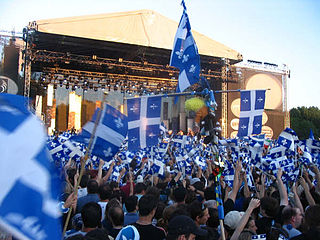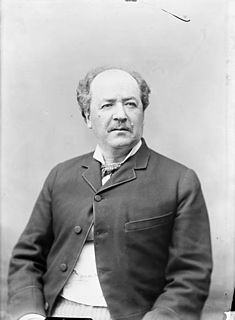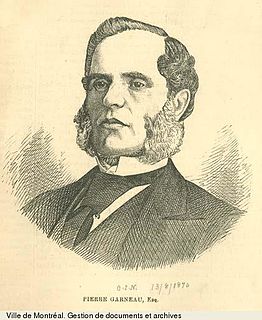
Joseph-Napoléon-Henri Bourassa was a French Canadian political leader and publisher. In 1899, Bourassa was outspoken against the British government's request for Canada to send a militia to fight for Britain in the Second Boer War. Prime Minister Sir Wilfrid Laurier's compromise was to send a volunteer force, but the seeds were sown for future conscription protests during the World Wars of the next half-century. Bourassa unsuccessfully challenged the proposal to build warships to help protect the empire. He led the opposition to conscription during World War I and argued that Canada's interests were not at stake. He opposed Catholic bishops who defended military support of Britain and its allies. Bourassa was an ideological father of French-Canadian nationalism. Bourassa was also a defining force in forging French Canada's attitude to the Canadian Confederation of 1867.

Louis-Alexandre Taschereau was the 14th premier of Quebec from 1920 to 1936. He was a member of the Parti libéral du Québec.

Quebec nationalism or Québécois nationalism is a feeling and a political doctrine that prioritizes cultural belonging to, the defence of the interests of, and the recognition of the political legitimacy of the Québécois nation. It has been a movement and a central issue in Quebec politics since the beginning of the 19th century. Québécois nationalism has seen several political, ideological and partisan variations and incarnations over the years.

This section of the Timeline of Quebec history concerns the events relating to the province of Quebec, Canada between the enactment of the British North America Act of 1867 and the end of the 19th century.

This section of the Timeline of Quebec history concerns the events relating to the province of Quebec, Canada between the beginning of the 20th century and the Westminster statute.

The National Bank of Canada is the sixth largest commercial bank in Canada. It is headquartered in Montreal, and has branches in most Canadian provinces and 2.4 million personal clients. National Bank is the largest bank in Quebec, and the second largest financial institution in the province, after Desjardins credit union. National Bank's Institution Number is 006 and its SWIFT code is BNDCCAMMINT.
The Banque Canadienne Nationale was a bank based in the province of Quebec, Canada. It was formed in 1924 from the merger of the Banque d'Hochelaga and the Banque Nationale, and operated until 1979, when it became part of the National Bank of Canada.

François-Xavier Garneau was a nineteenth-century French Canadian notary, poet, civil servant and liberal who wrote a three-volume history of the French Canadian nation entitled Histoire du Canada between 1845 and 1848.
The Provincial Bank of Canada was a Quebec-based bank in Canada that was the product of mergers between the Banque Jacques-Cartier (1861), the Banque d'économie de Québec (1848), the Banque populaire de Québec (1868), and the Unity Bank of Canada (1972).
Michel Bélanger, was a Canadian businessman and banker.

Joseph Royal was a Canadian journalist, lawyer, politician, businessman, and Lieutenant Governor of the Northwest Territories.
Maisonneuve was a former provincial electoral district in the Montreal region of Quebec, Canada.
Banknotes have been issued in Canada and the British colonies that confederated to form Canada from 1 July 1867.

Pierre Garneau was a Canadian businessman and politician.

Laurent-Olivier David was a Canadian journalist, lawyer, and politician.

Beaudry Leman was a Canadian civil engineer, politician and banker. He was the third mayor of Shawinigan Falls, Quebec (1902-1908). He was general manager of the Banque d'Hochelaga (1914-1924) and general manager (1924-1933) and president (1934-1947) of the Banque Canadienne Nationale.

Joseph Masson was a Canadian businessman, who is considered the first French Canadian millionaire.

Alfred Laliberté was a French Canadian sculptor and painter based in Montreal. His output includes more than 900 sculptures in bronze, marble, wood, and plaster. Many of his sculptures depict national figures and events in Canada and France such as Louis Hébert, François-Xavier-Antoine Labelle, Adam Dollard des Ormeaux, and the Lower Canada Rebellion. Although he produced hundreds of paintings as well, he is chiefly remembered for his work as a sculptor.
Louis Tourville was a Canadian banker and politician.

Georges-Élie Amyot was a French Canadian businessman and politician, and founder of Dominion Corset. He was worth $8 million in 1930, at the time of his death.














